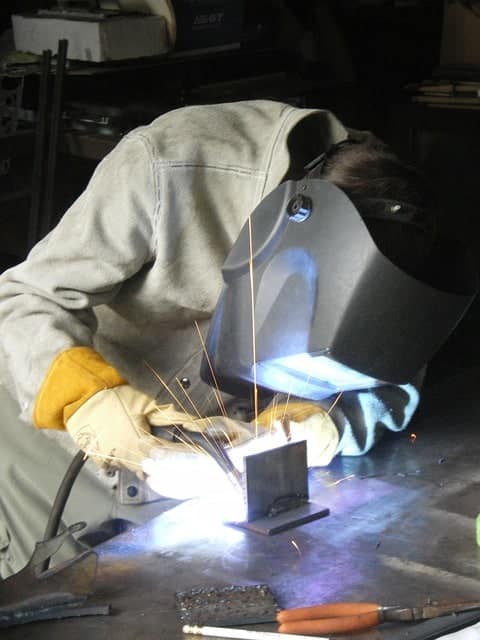
Welding is a skill that only develops with a lot of practice and patience. If you are just taking up Gas metal arc welding, then you first need to understand the basics behind it and learning how to weld safely while using right MIG welding techniques.
On the upside, when you equip yourself with all the needed basic skills and techniques then you can set up your own metalworking shop in your garage and start earning some side income as well. Even though it is a good idea to join a welding class for a few weeks, it is extremely important that you just don’t learn the theory part of MIG welding techniques alone, but have a lot of hours of practice with the proper equipment as well.
What is MIG Welding?
Contents
MIG Welding (GMAW) is one of the most widely used welding methods around the world to join two metals. The reason MIG welding is preferred over TIG welding and Stick welding is that it takes less time when compared with the other two and is also quite inexpensive. It is also quite easy to get people trained into MIG welding. Within just a few weeks of training, a novice in this area, with small MIG welder can easily handle basic repair and fabrication works with right GMA Welding techniques.
Gas or Flux
One of the basic things that a beginner welder needs to consider is whether he uses gas or a flux core wire as it determines the quality of the output, the welding techniques you can use, and the nature of the job as they slightly differ from each other. As you know, during the welding process, a large amount of heat is generated that breaks down the chemicals and other particles in the air into smaller molecules that will largely contaminate the weld piece. Only a shielding can help in preventing the metal from getting contaminated. The welding process also creates a tiny electromagnetic field that will also attract contaminants in the air onto the weld causing contamination to the piece. So the only way to prevent contamination is by using a shielding gas or a flux core wire.
Gas could be a bit costly and may require some upfront investment when compared to using flux, and it requires you to use the correct mixture of gas to get the desired results. While the flux core wires come equipped with a shielding substance that can protect the weld from getting contaminated. The main advantage with flux core wire is that you don’t need to drag around a gas tank along with you for the job. Using flux core wires can create more spatter that requires a lot of time to clean up, you can not usually do multi-pass welds and you always have to drag the nozzle form the weld pool (backhand methods).
How to use MIG welder with gas – Welding Positions and Techniques
The welding position and technique is very important to achieve the desired results in mig welding. Below we will look at some of the best mig welding positions that you can use during welding.
Flat Position MIG Welding Technique
When it comes to MIG welding, the flat welding position is the easiest position where the MIG gun will be held in an angle of 35/45 degrees and pointed down towards the direction of the weld. For flat position welding, it is recommended to use a high-voltage setting that creates a hot arc and using a steady motion is important to create a beautiful bead. You can use any pattern motion as long as you see that the weld is penetrating nicely. If you are beginner, then set the machine as high as you can as this will ensure that your weld penetrates deep.
Horizontal Position MIG Welding Technique
When compared to flat position welding, horizontal welding is a bit difficult, but with proper practice, you can get the hang of it easily. For the horizontal position welding technique, you need to point the MIG gun upward in an angle between 35-45 degrees and tilted at an angle between 15-35 degrees towards the weld position. For horizontal position welding, it is best to go for the whipping and circular motion welding. Unlike flat position welding, you can’t crank up the welding gun to achieve weld penetration as horizontal position welding requires skill and technique to achieve the desired penetration.
Vertical Down
Vertical down MIG welding technique is also an easier welding position when you start from the top and gently work your way down. In this welding technique, the MIG gun needs to be held at a tilted angle between 35-45 degrees and the arc needs to stay ahead of the puddle all the time and move the electrode wire in a side to side motion to achieve the desired weld penetration.
Vertical Up MIG Welding Technique
When it comes to the MIG welding position, one of the most difficult techniques is the vertical up position as you need to have the MIG gun pointed upwards at an angle of 35-45 degrees. And during vertical up GMAW welding, the welder needs to create a “weld shield” to move upwards.
Forehand vs Back-Hand Welding
Generally, only two types of MIG welding techniques are followed, forehand and backhand welding. If the MIG gun is pushed towards the direction of the weld, it is referred to as forehand welding. You get shallow penetration in forehand welding whereas in backhand welding you drag the machine like in stick welding to get deep and narrow penetration.
Conclusion
I hope this article about How to weld with a wire feed welder provided you with all the basic information you need to lay some beads. These MIG welding techniques will surely give you an understanding of the basics of the different welding positions.
